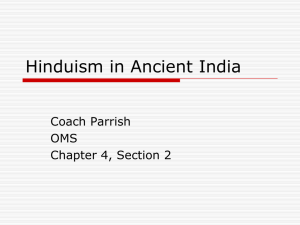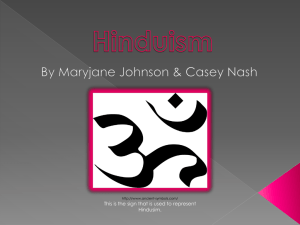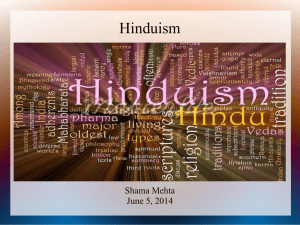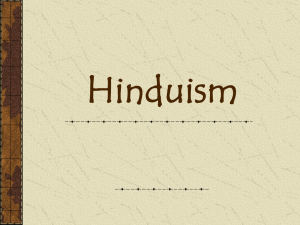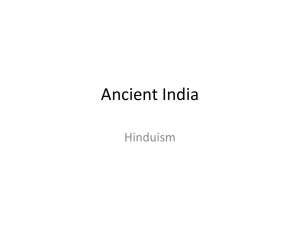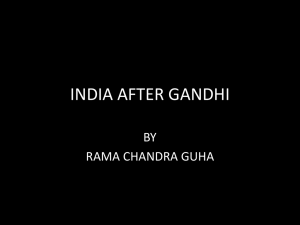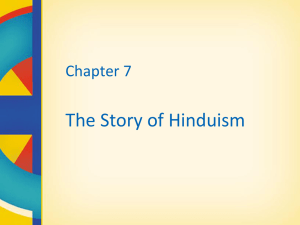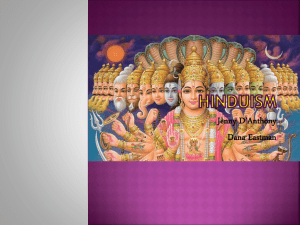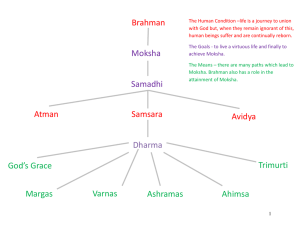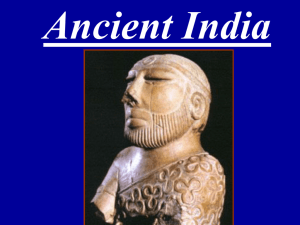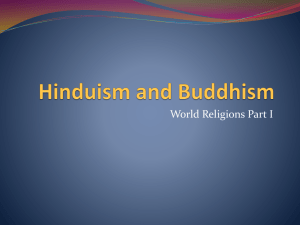10 NonTheistic-Hinduism
advertisement
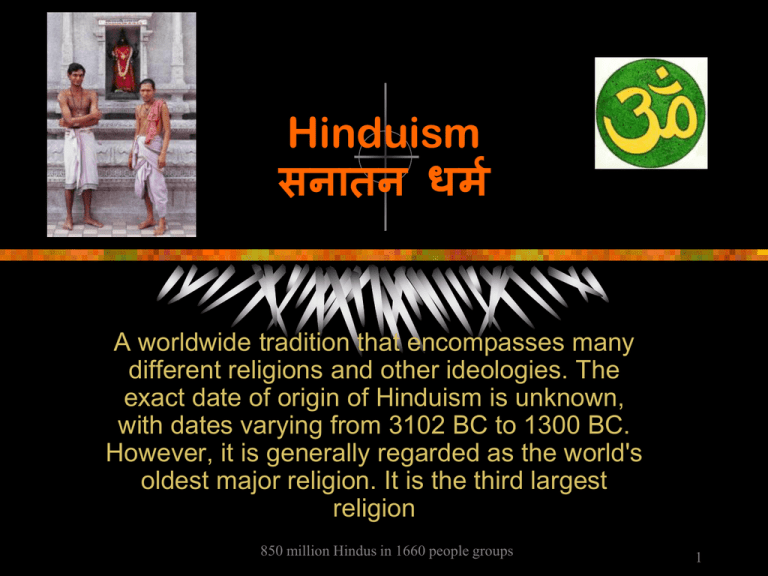
Hinduism सनातन धर्म A worldwide tradition that encompasses many different religions and other ideologies. The exact date of origin of Hinduism is unknown, with dates varying from 3102 BC to 1300 BC. However, it is generally regarded as the world's oldest major religion. It is the third largest religion 850 million Hindus in 1660 people groups 1 Hinduism: Indian Pantheism/Polytheism Hindu Mandir (temple) in Atlanta Pantheistic religion of 1 Billion (98%) of India’s 1.3 billion people with approximately 1.2 Billion followers worldwide. Not a unified religion, but a congress of religions (Hinduism, Buddhism, Jainism, Sikhims, etc.) called dharmic religions (“the way of the higher Truths,” a lifestyle that leads to the least accumulation of karma, thus the fastest path to personal liberation, moksha) Hindu ideas have spread to Western world through Hindu sects, gurus and New Age movement 850 million Hindus in 1660 people groups 2 Hindu view of “God” Brahman is the one impersonal, ultimate, but unknowable, spiritual reality. – Sects of Hinduism personalizes Brahman as Brahma (creator, with four heads symbolizing creative energy) Most worship two of Vishnu’s (or Narayana) 10 mythical incarnations: Krishna and Rama. On special occasions Hindus may worship other gods. There is a strong belief in astrology, evil spirits and curses 850 million Hindus in 1660 people groups 3 Hindu view of “God” Christian Response: If God is impersonal, then the impersonal must be more important than any personal. But our life experience is that the personal is more important than any impersonal (we treat our children different from a rock in a field!) – The Bible presents God as a Personal Being with whom we can relate. The Bible teaches that God has personal attributes: He talks, rebukes, feels, becomes angry, is jealous, laughs, loves, and even has a personal name. (Gen 1:3; 6:6, 12; Ex 3:15) – The Bible warns Christians to avoid all forms of idolatry (Gen 35:2; Ex 23:13) – No idol or pagan deity is a representation of the true God. They are all false deities and must be rejected! 850 million Hindus in 1660 people groups 4 Hindu Origin: world’s oldest existing major religion Thirumala: rich vaishnavite temple Also known as Sanatana Dharma origin is between 31001300 BC Dharma, “manner of being,” that teaches the value of pure and right actions, to give up bad and wrongful actions, to meditate on God, or your own self, in order to escape the endless cycle of life and death (reincarnation) and obtain moksha. The Rig Veda, dating from 1500-1300 BC, are books of spiritual philosophy – Codified around 600 BC, but the oldest text is 200 BC – Hinduism is more of a philosophy than a holy book, thus difficult to date. It is difficult to date since it is not an organized religion 850 million Hindus in 1660 people groups 5 Hindu Attitude towards organized religions as expressed by Swami Vivekananda: If you want to be religious, enter not the gate of any organized religion. They do a hundred times more evil than good, because they stop the growth of each one's individual development... Religion is only between you and your God, and no third person must come between you. Think what these organized religions have done! What Napoleon was more terrible than those religious persecutions? If you and I organize, we begin to hate every person. It is better not to love, if loving only means hating others. That is no love. That is hell! If loving your own people means hating everybody else, it is the quintessence of selfishness and brutality, and the effect is that it will make you brutes. 850 million Hindus in 1660 people groups 6 Four Major Divisions of Hinduism 2. Shaktism, who worship Shakt or Devi, the 3. 1.Vaishnavism Saivism or Shaivites up(“the 80-85% purewho one”) make up personification ofmake primordial energy andworship source of 20-25% (“the preserver”) monotheistic 4.Vishnu Smarthism is monist inistheology all divine and cosmic evolution. Her female side is • Believe Shiva there is the is third God asis the Destroyer, one of •divinity onlyform one of God, simultaneously permeates Smartha philosophy believes inwho the essential sameness ofthe all all and masculine side energy (which is trimurti (popularly calledit,the "Hindu trinity"). creation and existsofbeyond being both immanent and of the deities, the unity Godhead, and its conceptualization powerless without the female side) transcendent myriad deities of India as various manifestations of the one Lord Shiva. Locks of hair represent the Vishnu, “Preserver” who River Devi as manifested himself as Krishna to Ganga considered Vaishnodevi, be Mother, a goddess in Divine • In the trimurti, Shiva is the destroyer, while Brahma and Vishnu Hinduism. goddess of In Hindu divine power.and Smartas (followers of Smarthism) accept and are Creator Preserver, respectively. However, even though They acknowledge the existence of many lower Gods under the mythology, • Nowhere in religious history isShiva, there a more strength, female when he represents he is viewed as a positive force (The Ganga worship the six destruction, forms of God, (Ganesh, Sakti, Vishnu, descended from Supreme One.ofThese Gods areisencompassed by Him, seen as aspect of divinity With all Hindus, there a strong belief in all Destroyer Evil), completely female-oriented system Surva and Skanda) and the choice of the form of God is up to the heavens, the Earth either as manifestations of the Supreme Being or as powerful could not bear her flow the individual worshipper since different aspectsto of God are paths religions lead entitiesbeing who aretrue permeated by Him,that as is all Creation.one God so Lord Shiva agreed held to be equivalent. to bear it. Lord Shiva's or source, whatever one chooses to call the • Other denomination of Hinduism, believes that Vishnu incarnates skin turned bluish as he ultimate truth. is theand major problem in periodically for theThis establishment protection of righteousness, drank the Halahala poison that came out of good and destruction of evil evangelism: Christ is the only way, the Truth the Churning of the ocean of milk. and the Life – not just another one to add! 850 million Hindus in 1660 people groups 7 Four Goals in the Hindu life 1. 2. 3. 4. kama, artha, dharma and moksha. Kama: all humans seek kama (pleasure, physical or emotional) and Artha (power, fame and wealth), but soon, with maturity, learn to govern these legitimate desires within a higher, Dharma: a pragmatic framework or moral harmony in all. Moksha: the only goal that is truly infinite, whose attainment results in absolute happiness, is moksha or liberation, (also Mukti, Samadhi and Nirvana in different sects) from Samsara or reincarnation, the cycle of life, death, and existential duality. 550 million Hindus in 1660 people groups Sadhus (Hindu ascetic) are often seen meditating in padmasana (lotus pose) having given up the first three life goals to pursue moksha. 8 Dharma: the nature of being Dharma is conformity to a Divine or Creative Principle at work in an individual and in nature. The individual’s internal law to which obedience of life is to be lived in accordance with a Divine will – the primary purpose of one’s life Evidence is seen in all nature which conforms to the nature of their being, thus dharma is aligning of the human body, mind and soul in harmony with nature Foundation principle of the caste system: one must obey an “internal decree” from which they cannot stray 850 million Hindus in 1660 people groups 9 Four Levels of the Hindu Life The human life is also seen as four Ashramas ("phases" or "stages"). They are Brahmacharya, Grihasthya, Vanaprastha, and Sanvas. Brahmacharya, the first quarter of one's life, (literally "grazing in Brahma") is spent in celibate, sober and pure contemplation of life's secrets under a Guru, building up body and mind for the responsibilities of life. This is the phase where a human obtains knowledge of God and the world, while learning to keep strict control of his mind, senses and body. Grihastya is the householder's stage, alternatively known as samsara, in which one marries and satisfies karma and artha within a married life and professional career. Vanaprastha is gradual detachment from the material world, ostensibly giving over duties to one's sons and daughters, spending more time in contemplation of the truth, and making holy pilgrimages. Sanyasa, the individual goes off into seclusion, often envisioned as the forest, to find God through Yogic meditation and peacefully shed the body for the next life. 850 million Hindus in 1660 people groups 10 The Caste System Caste is varna meaning “color.” Castes originally had equal standing in the society and were based upon the duties to society and everyone working together towards the welfare of the society. According to this understanding, discrimination by caste is a perversion of dharma's true meaning. Four major groupings – Brahmins – Priestly cast – Kshatriyas – Warriors – Visyas, Merchants and artisans – Shudras, serfs – “Outcastes” 100 million are Closely bound with idea of Karma – Status of rebirth is determined by thoughts, words, or deeds during this life – Poverty, riches, health and disease are ascribed to karma Caste based discrimination is so deeply planted in the Indian consciousness that even Christian converts have been known to separate church meetings for different castes. A number of Muslim communities have retained caste practices as well. 850 million Hindus in 1660 people groups 11 Hindu philosophy: achieving oneness with the World-Force Hindu thought is monistic or pantheistic –Ultimate reality is one principle, Brahman – Not a personal God but the impersonal “Force”, indistinguishable from universe, “world-soul” Since only one principle to reality, our individual existence is only a temporary illusion (maya), as is the physical world Our individual soul or self (atman) is temporarily separated from the universal “World-soul” (Brahman) Time is viewed as endless cycle of reincarnations, symbolized in the wheel of life (samsara) leading to eventual reunion with Brahman Life in the physical world is only an evil illusion which obscures our real unity with Brahman So life’s goal is to be liberated from these cycles “Liberation” is called Moksha, or the Buddhist term Nirvana12 850 million Hindus in 1660 people groups Liberation paths No forgiveness nor escape from karma, so path to Liberation is difficult and rigorous No agreement as to how oneness with the infinite (yoga= “yoking”) is attained: Illustrates with use of jar – glass jar hinders union of air within from being one with universal air without. (Jar = body) Through yoga we are liberated from the illusion of our individual physical self and we merge with the Infinite. The one who knows this can say, “I am Brahman” and becomes the “All” 850 million Hindus in 1660 people groups 13 Four major Paths of Yoga 1. 2. 3. 4. Path of Meditation (Raja Yoga) – 8 branches Path of works of selfless service to the Divine (Karma Yoga) Path of intellectual analysis or the discrimination of truth and reality (Jnana Yoga) Path of devotion or ritual (Bhakti Yoga) Hath Yoga are various physical and breathing exercises and purification techniques A proficient in yoga is called a yogi One who attains a high measure of world-denial is called a sadhu (“simple”) 850 million Hindus in 1660 people groups 14 Hindu Scriptures: Vedas and Upanishads Sanskrit texts on palm-leaf Four Vedas are a complex of Sanskrit literature written over centuries beginning at 1200 BC, considered inspired Upanishads about 600 BC—giving the first indications of karma and reincarnation for meditation and philosophy. These are commentaries on the Vedas. See http://www.indianest.com/hinduism/037.htm for more. – Consist of hymns, prayers, formulas, incantations, myths and legends Bhagavad Gita, an epic conversation between Arjuna, a warrior, and Lord Krishna prior to battle. It emphasizes Karma Yoga and the 10 incarnations of Vishnu, especially Lord Krishna 850 million Hindus in 1660 people groups 15 Characteristics of Hinduism 1. Vegetarianism is practiced by about 30% of India, especially in the south and Brahmin enclaves in the exterior. 1. Though not a dogma, it is recommended as a sattwick (purifying) lifestyle 2. Sacred Cow: Those who do eat meat predominantly abstain from beef, some even going so far as to avoid leather products. – This is most likely because the largely pastoral Vedic people relied so heavily on the cow for all sorts of dairy products, tilling of fields and fuel for fertilizer that its status as a willing 'caretaker' of humanity grew to identifying it as an almost maternal figure (so the term gau mata). – Thus, while most Hindus do not worship the cow, and scriptural injunctions against eating beef arose long after the Vedas had been written, it still holds an honored place in Hindu society. 3. Multiple Acceptance of Gods: Hindus understand that the one truth may be seen as different to different people. Hinduism encourages devotees to describe and develop a personal relationship with their chosen deity (ishta devata) in the form of a God or Goddess. 850 million Hindus in 1660 people groups 16 Popular Hinduism Average Hindu probably understands little of this complex philosophy Life is governed by customs (dastur), the Bindis are worn caste system and the veneration of the cow by Hindu women on their forehead Most Hindus are devoted to one of their to symbolize the many deities opening of their India is filled with temples and shrines with spiritual third eye ancient and a few obscene sexual carvings for enlightenment Temples are the abodes of the gods, not places of worship Brahmin temple priests serve the gods, while worshipers bring offerings Place of women is especially bad (at one time killed when husband died, willingly burnt together in funeral fire) 850 million Hindus in 1660 people groups 17 International Hinduism Complexities of Hinduism demands gurus to explain it to inquirers Modified recently in sects (Hari Krishna and “Divine Light Mission”) Buddhism and Jain religion split off from Hinduism about 2000 years ago About 500 years ago an attempt to reform Hinduism with Islamic ideas resulted in Sikh religion (from shishya, “disciple”) of Guru Nanak, Sikh’s first guru – Nanak said, “Let no man in the world live in delusion. Without a Guru none can cross over to the other shore” (or 18 reach moksha) 850 million Hindus in 1660 people groups Witnessing to Hindus Pray and trust the Holy Spirit to use the gospel message to reach the hearts and minds of your Hindu friends Show the failure of everyone to obey God’s basic laws Show the love of God in sending Christ to pay for our sins Stress the uniqueness of Jesus Christ as God’s revelation of Himself – the only one God sent to die for us Stress the necessity of following Jesus to the exclusion of all other deities. Keep the gospel presentation Christ-centered Share the assurance of salvation that God’s grace gives you and about your hope in the resurrection. Make sure you communicate that your assurance is derived from God’s grace and not from your good works or your ability to be spiritual (1 Jn 5:13) Give a copy of the NT or the gospel of John. Mark out key passages that explain salvation. 850 million Hindus in 1660 people groups 19 850 million Hindus in 1660 people groups 20 850 million Hindus in 1660 people groups 21
